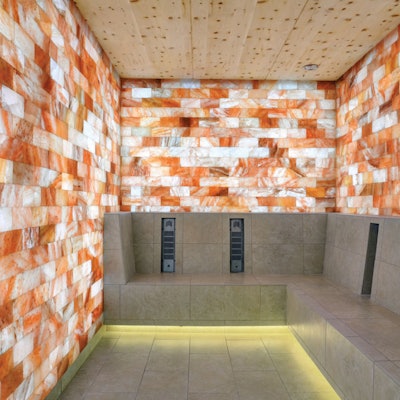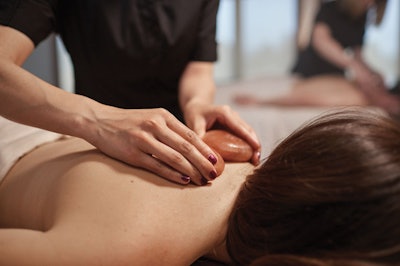 [Images: Courtesy of Strata Integrated Wellness Spa]
[Images: Courtesy of Strata Integrated Wellness Spa]Relaxing on the beach has long been considered the epitome of a stress-free vacation, but it’s not just the sand and sun that do a body good. Turns out, breathing in salty air can actually benefit one’s health and well-being, especially when it comes to respiratory ailments, reports the Global Wellness Institute (GWI). So it’s no surprise that salt therapy, also called halotherapy or speleotherapy, has been popping up in more and more spas as part of their holistic wellness offerings. In fact, this latest trend has the potential to deliver long-term benefits to spas and clients alike, says Ann Brown, founder and CEO of Saltability and co-chair of the Exploring Salt & Halotherapy Initiative. “Spas are looking for ways to be hip and boost revenue—salt therapy does both,” she notes.
Halotherapy first took hold in Medieval Europe when monasteries were in charge of hospitals and clinics, explains Rebecca Johnston, spa director of Strata Integrated Wellness Spa at Garden of the Gods Resort and Club in Colorado Springs, Colorado. “The monks would recommend salt caves for therapeutic reasons. Respiratory and skin issues were reportedly improved by that environment,” she says. Similarly, Polish salt cave miners in the 1800s didn’t appear to experience the lung problems that coal miners did; they even seemed resistant to respiratory illnesses, including the flu and tuberculosis, continues Johnston. “So doctors began using the salt caves as therapy for all sorts of ailments,” she says.
In general, halotherapy refers to micron-sized particles of salt that are either inhaled or absorbed through the skin. “Salt has anti-inflammatory and antimicrobial properties, and it’s super absorbent,” says Steve Spiro, founder and CEO of Global Halotherapy Solutions and co-chair of the Exploring Salt & Halotherapy Initiative. He adds that this can help detoxify the body and alleviate skin irritation, and that as awareness of these purported benefits increases, so too does the demand for salt therapy offerings. “Six years ago, there were only 200 facilities offering halotherapy in the U.S. Now there are around 2,000; spa-goers are seeking this wonderful—and low- cost—modality,” says Spiro.
RELATED: The Wellness Benefits of Maya Abdominal Therapy
There are several ways to fit salt therapy into the spa setting. Salt rooms are the largest undertaking, as they typically include salt walls and a halo-generator that disperses microscopic salt particles into the air— allowing guests to simply relax and breathe them in. “Just like steam rooms are wonderful before a massage or facial, the salt room is time well spent afterward, as the client’s body and spirit continue to integrate treatment benefits,” Johnston says of Strata’s Himalayan salt room. “Every guest has a positive experience there; they can leave their stress behind.”

On a smaller scale, salt is an ideal element for detoxifying baths, and salt stones can be used in massage therapy to lightly exfoliate. Strata implements obsidian-like, Himalayan crystal salt stones that contain 84 naturally occurring minerals in its Strata Hot Stone Massage (50 min./$140; 80 min./$195). “These stones carry a very soft and penetrating heat that guests find extremely relaxing, and our therapists report that they’re easy to use and maintain,” says Johnston.
RELATED: The Healing Power of Sound Therapy
The spa also has a salt bar where guests create their own bath salt recipe from four essential oil and dead sea salt offerings, with a pink Himalayan salt base. “We provide the jars and they enjoy crafting a beautifully artistic presentation, much like a sand art project,” notes Johnston. “It has been highly successful in our reception and retail areas.”
Even simple salt additions have the potential to convert occasional guests into regulars, says TouchAmerica founder Stewart Griffith. “Clients will benefit from one treatment, but remind them that halotherapy is like exercise: The more often they do it, the more benefits they’ll reap.” Of course, anything that enhances the overall experience will also help improve profitability. “Many spas have 8 to 12 rooms and not enough therapists to fill them,” says Brown. “Consider converting one of these spaces into a revenue-producing area with a salt wall and halo-generator.”
Smaller spas unable to dedicate an entire room to salt can still add a halo-generator to the space where massages or yoga are performed, suggests Spiro. And Brown notes that they can replace some of the cedar planks in dry saunas with Himalayan salt blocks. Plus, ROI is typically high thanks to salt therapy’s relatively low maintenance. “It’s an automated wellness service that requires no extra labor,” reminds Spiro.
–by Stephanie Vozza
This story first appeared in the April issue of Dayspa magazine. To receive the magazine, click here to subscribe.











